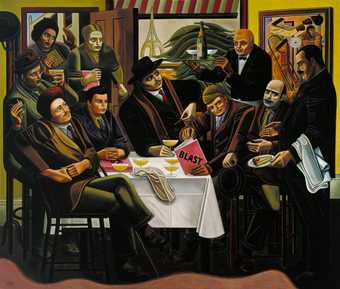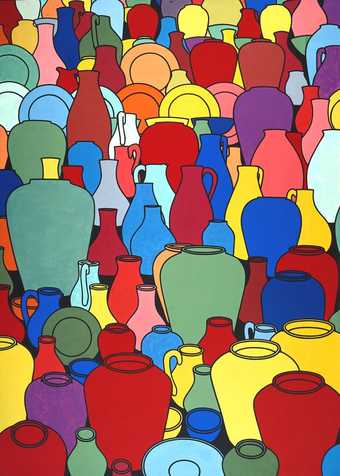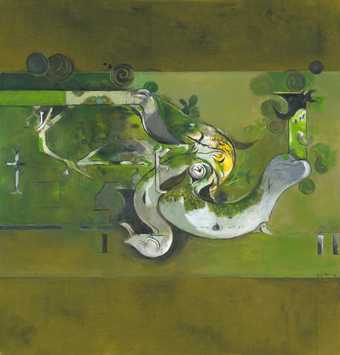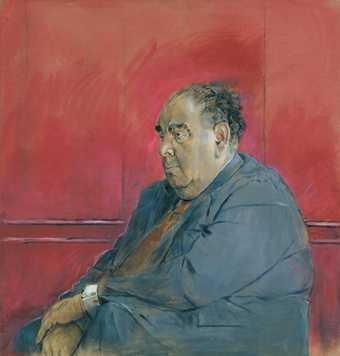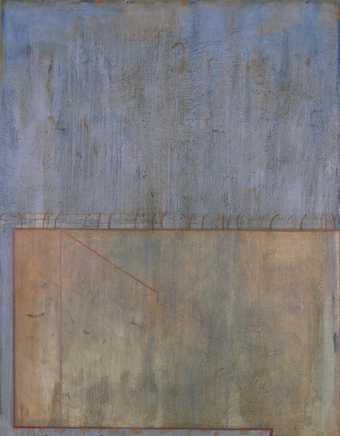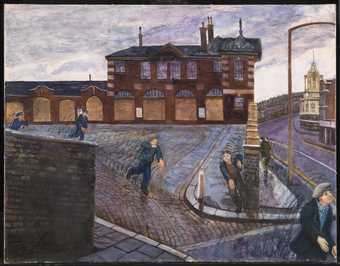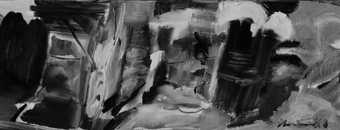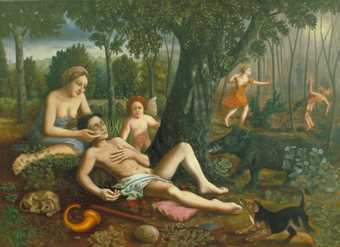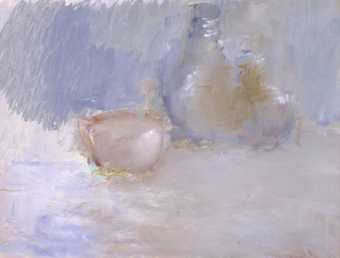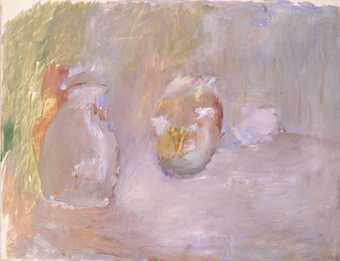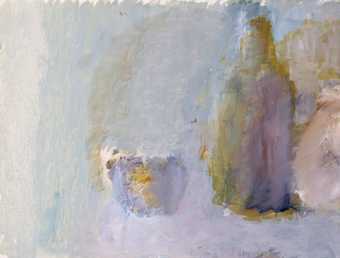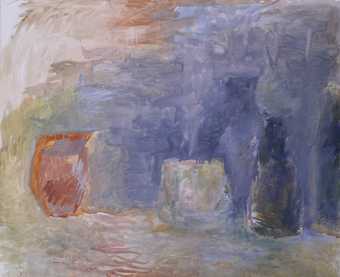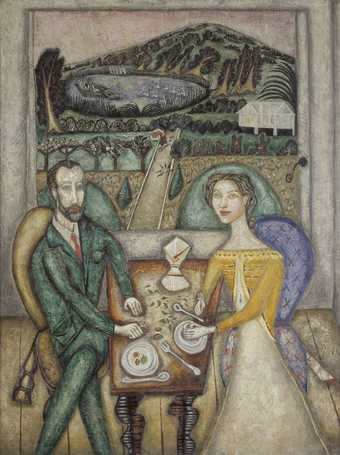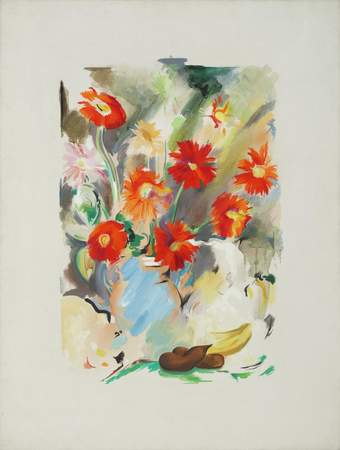
Not on display
- Artist
- Helen Lessore 1907–1994
- Medium
- Oil paint on canvas
- Dimensions
- Support: 1680 × 2137 mm
frame: 1700 × 2160 × 40 mm - Collection
- Tate
- Acquisition
- Purchased 1981
- Reference
- T03288
Display caption
Helen Lessore studied at the Slade School under Henry Tonks. From 1951 she was director of the Beaux Arts Gallery in London, creating what has been described as 'one of the most individual and influential nurseries of talent in the country'. After the gallery closed in 1965 she was able again to concentrate on her own painting. 'Symposium I' depicts ten artists closely associated with the Beaux Arts, some of whom are represented in this room. Clockwise from top left they are Raymond Mason, John Lessore, Francis Bacon, Lucian Freud, Michael Andrews, Frank Auerbach, Leon Kossoff, Euan Uglow, Myles Murphy and Craigie Aitchison. Helen Lessore wrote: 'I have always been fascinated by groups of people...
Gallery label, September 2004
Does this text contain inaccurate information or language that you feel we should improve or change? We would like to hear from you.
Catalogue entry
T03288 SYMPOSIUM I 1974–7
Inscribed ‘H L 76’ near left edge, centre; and ‘Symposium I. 1974–77 Helen Lessore’ on canvas turnover
Oil on canvas, 66 3/8 × 84 3/4 (167.8 × 213.7)
Purchased from 12 Duke Street Gallery (Grant-in-Aid) 1981
Lit: Philip Oakes, ‘Following the Life Line’, The Sunday Times, 18 January 1976 (includes photograph of the artist showing part of T03288 in an earlier state)
The Beaux Arts Gallery, Bruton Place, London was founded by Frederick Lessore. After his death in 1951 it was continued by Helen Lessore, his widow, until she closed it in 1965, since when her main activity has been painting. A substantial account of the last fourteen years of the Beaux Arts Gallery is given in Andrew Forge, ‘Helen Lessore and the Beaux Arts Gallery’, in the catalogue of the exhibition of that title held at Marlborough Fine Art, February 1968.
'Symposium I’ represents ten artists closely associated with the Beaux Arts Gallery under Helen Lessore.
Reading clockwise, starting with the figure at top left, they are:
Raymond Mason
John Lessore
Francis Bacon
Lucian Freud
Michael Andrews
Frank Auerbach
Leon Kossoff
Euan Uglow
Myles Murphy
Craigie Aitchison
Beside Craigie Aitchison is his Bedlington terrier, Wayne. Helen Lessore has included several of these artists in paintings of groups of people in other settings. Eight of the ten artists in the Tate's picture had exhibitions at the Beaux Arts Gallery, the exceptions being Freud and Murphy. A list of the many artists who had exhibitions under Helen Lessore is given in the Marlborough Fine Art catalogue already mentioned.
Helen Lessore provided the following statement on ‘Symposium I’ in January 1983:
'I have always been fascinated by groups of people, especially seated round a table towards the end of a meal. In the course of long dreaming, somehow a number of artists gathered round my table, and years of my life at the gallery were telescoped and condensed into this scene. I don't think there was anything arbitrary; it all seemed to grow of itself.
'The setting is a free adaptation of parts of the gallery building, but opened to the outside world-which is a memory of a walk by the Seine, because I think I felt that Paris was more closely tied than London to the standards by which I judged everything. It was the permanent shadowy background of the life of the gallery.
'The composition is intended to convey that the artists are talking with the utmost seriousness about art - what they believe, what they are trying to do, and so on.
'Hannah Arendt drew a distinction between “work” and “labour” - labour being the activity of a slave - the hewing of wood and the drawing of water, which has to be done over and over again to keep things going, while “work” is the activity of a free man, involving choice, imagination, skill and resulting in some achievement, some creation. “The artist”, she says, “is the only worker left in a labouring society”.
'Of course, one is meant to understand “art” in its widest sense; and roughly, what she says corresponds to what I myself felt about art and its importance and the present decline of civilization. And this picture is meant to be more than a record of particular things, or a tribute to particular individuals. The figures are indeed portraits, as true as I could make them, but over and above that they stand for all artists, as being the salt of the earth, the leaven of society, the only hope for civilization; so that in my mind this general aspect of the subject lifted the particular one above the category of “genre” into that of the historical, and even religious - like - for instance - the “Nine Worthies” of the “Heroes Tapestries” [XIV century French tapestries in The Cloisters, New York City, where Helen Lessore saw them in spring 1975]’.
The following additional notes are drawn from the artist's replies to questions and have been approved by her. Helen Lessore usually first makes a sketch on paper before beginning a painting. In this case she made two, both now in a private collection. (The owner writes that both are on grey card, 12 × 9 1/8 inches, and use collage. The composition is roughly the same as in the painting but some of the figures differ in certain details and there are no bottles or glasses). She also asked some of the artists to sit for individual preparatory drawings. These included Aitchison, Auerbach, Kossoff, Murphy and Uglow. A drawing of Auerbach sitting as seen in the painting is in the Arts Council's collection (repr.Arts Council Collection, 1979, p.161). The image of Raymond Mason was based on an earlier drawing of him from memory. Other preparatory drawings were made after Helen Lessore had studied photographs she happened to have of the artists in different postures from those shown in the painting, these elicited memories of the postures seen in the finished work.
Although the Tate's painting is inscribed ‘76’ in the picture, Helen Lessore later resumed work on it. The changes she made were not substantial and were completed in 1977. At about the same time she also thought she had completed ‘Symposium II’, a canvas of the same size, also begun in 1974 and representing the same ten artists in the same grouping but with different still-life details and a different landscape background, and in stronger colours. In fact she resumed work on this picture, and completed it, in 1983. ‘Symposium II’ is painted over an abandoned first version of ‘Symposium I’. The setting of Paris is replaced by one evoking Athens, Crete and Patmos following Helen Lessore's visit to these places in 1976. It reflects among other things her keen response to the strong light and antique art of Greece. Helen Lessore sees the design of this second painting as being more formal and static than that of ‘Symposium I’. Whereas the first painting represents the active side of her life, the second is more contemplative, a quality she considers ultimately more fundamental.
Published in:
The Tate Gallery 1980-82: Illustrated Catalogue of Acquisitions, London 1984
Explore
- domestic(1,795)
-
- dining room(64)
- art gallery(245)
- art and craft(2,383)
-
- drawing(221)
- dinner party(132)
- food and drink(980)
-
- drink, wine(58)
- fruit - non-specific(173)
- glass(153)
- actions: expressive(2,622)
-
- talking(602)
- sitting(3,347)
- man(10,453)
- group(4,227)
- Aitchison, Craigie(1)
- Andrews, Michael(2)
- Auerbach, Frank(2)
- Bacon, Francis(31)
- Freud, Lucian(13)
- Kossoff, Leon(5)
- Lessore, John(3)
- Mason, Raymond(1)
- Murphy, Myles(1)
- Uglow, Euan(1)
- groups(310)
- individuals: male(1,841)
- cities, towns, villages (non-UK)(13,323)
-
- Paris - non-specific(392)
- France(3,508)
- River Seine(364)
- England(19,202)
- arts and entertainment(7,210)
-
- artist, painter(2,545)
- artist, sculptor(1,668)
You might like
-
William Roberts The Vorticists at the Restaurant de la Tour Eiffel: Spring, 1915
1961–2 -
Patrick Caulfield Pottery
1969 -
Graham Sutherland OM Form over River
1971–2 -
Graham Sutherland OM Lord Goodman
1973–4 -
Prunella Clough By the Canal
1976 -
Carel Weight Clapham Junction
1978 -
Ivon Hitchens A View from my Roof
1978 -
Stephen McKenna Venus and Adonis
1981 -
Adrian Stokes Still Life: Last Eleven (No. 6)
1972 -
Adrian Stokes Still Life: Last Eleven (No. 5)
1972 -
Adrian Stokes Still Life: Last Eleven (No. 8)
1972 -
Adrian Stokes Still Life: Last Eleven (No. 7)
1972 -
Adrian Stokes Still Life: Last Eleven (No. 3)
1972 -
Cecil Collins The Artist and his Wife
1939 -
Richard Hamilton Flower-piece II
1973

